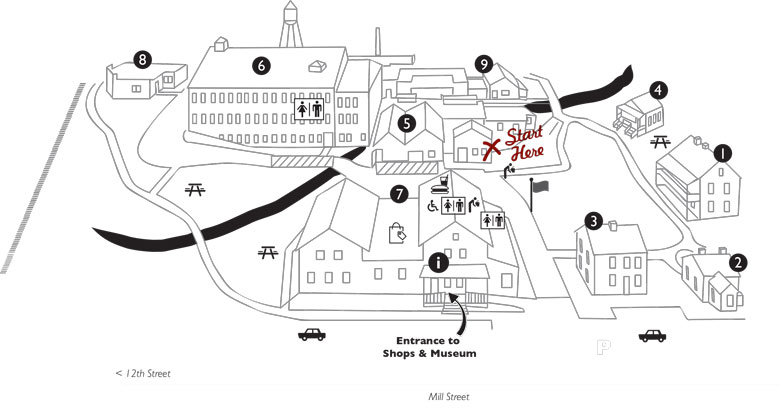So Much to See and Do!
Map Sections
1 Jason Lee House: Served as headquarters for Methodist Mission operations in the Oregon Country; it also hosted meetings of the early provisional government and served as an early post office. The Lee House was moved here from its original location north of downtown Salem in 1965.
2 Boon House: The oldest single family house still standing in Salem. John Boon and his family came over the Oregon Trail in 1845. After a brief stint homesteading, the family relocated to Salem where John D. Boon became very involved in business and politics. He co-founded the first woolen mill in Oregon and served as the last Territorial and the first State Treasurer in Oregon. The Boon House was moved from north of downtown to its current location in 1972.
3 Parsonage: The second frame structure built with lumber from the Mission’s sawmill. Originally designed as a duplex, it housed those missionaries who oversaw the Indian Manual Training School. This was the only building retained by the Methodist Church when the mission closed and it served as the parsonage for their minister and as a base for circuit riders, or itinerant preachers in the valley.
4 Pleasant Grove Church: Finished in April of 1858, this church represents a meetinghouse-style associated with early country churches. It is the oldest surviving Presbyterian Church in the Pacific Northwest. The building was moved from outside of Aumsville to the WHC grounds in 1984.
5 Dye House: During the Mill’s operation (1889-1962), dying was done in a series of interconnected sheds and buildings. Today’s Dye House is a reconstruction using an original wall on the south side.
6 Mill Building: This brick building was designed by Walter David Pugh in 1896, after a fire destroyed the original 1889 wooden structure. The construction bid was awarded to John Gray, who with masonry foreman Henry Luker and general grounds foreman J. Cordingly marshaled a crew of forty men to complete construction in a little less than six months. Over 250,000 bricks from the kilns at the Oregon State Penitentiary were used.* In 2006, major rehabilitation of the building’s exterior was completed with its designation by the National Park Service as an American Treasure.
*learn more about the construction of the mill (and see sources for this information) here.
7 Warehouse Building: Formerly housed the wool and rag warehouses with a drive-in loading dock in the middle. Today the warehouse serves and the hub for visitors services and includes the museum’s orientation center, retail stores and galleries (click here for more information), and offices.
8 Library & Archives: This mid-20th century stucco building was built to house the mill’s retail store and offices and replaced a two story house that once stood here. Today the building houses extensive unique historical collections, including records from the Thomas Kay Woolen Mill and the Marion County Historical Society. It is open to researchers Tuesday-Friday noon-4pm.
9 Mentzer Machine Shop: Named for the Mill’s faithful and popular millwright, Wayne Mentzer (millwright for 60 years from 1924-1984), the machine shop is where his valuable work took place. The moving machinery and tools on display are original to the Mill and were used for everything from making machine parts to repairing structures.



